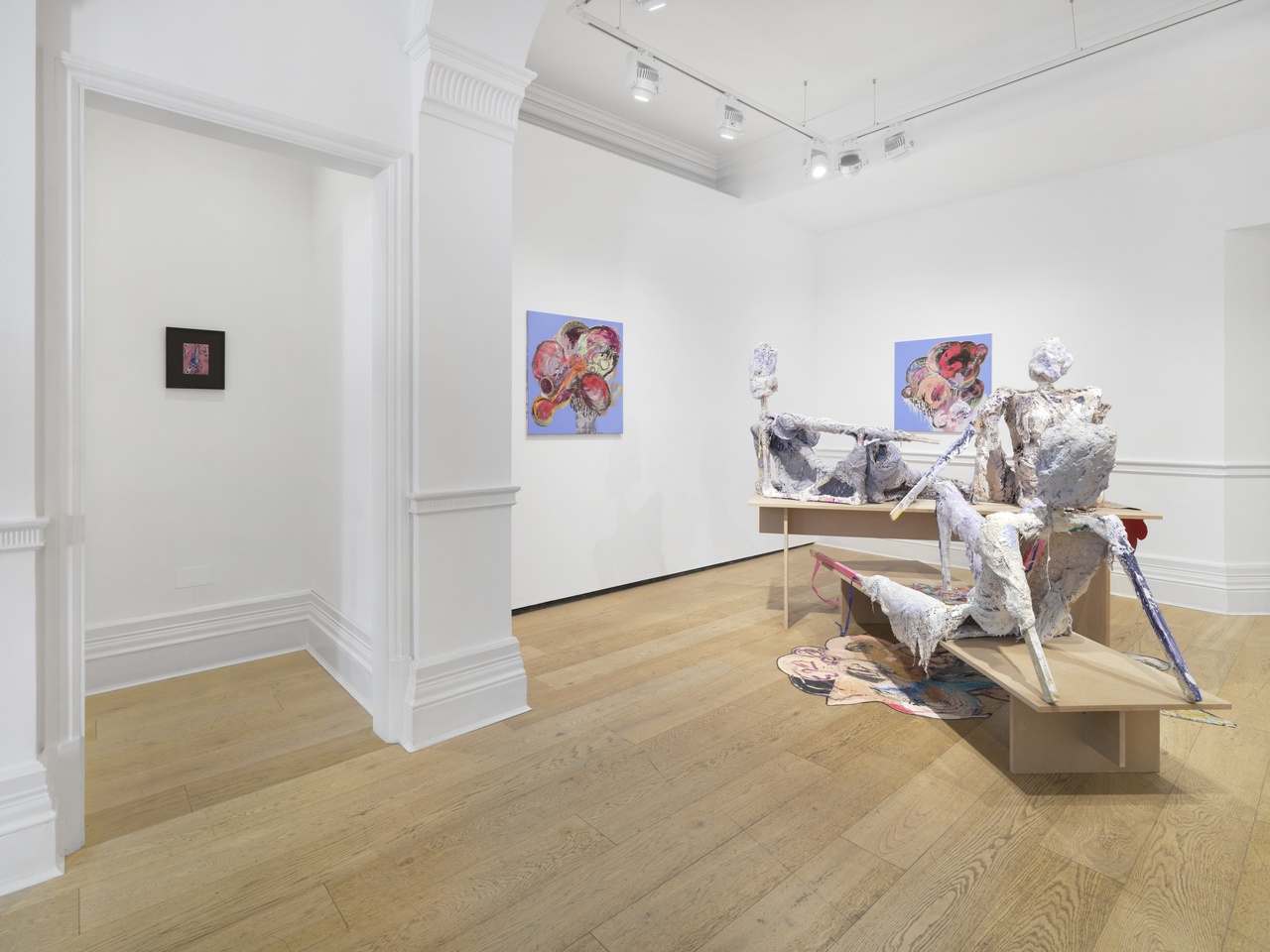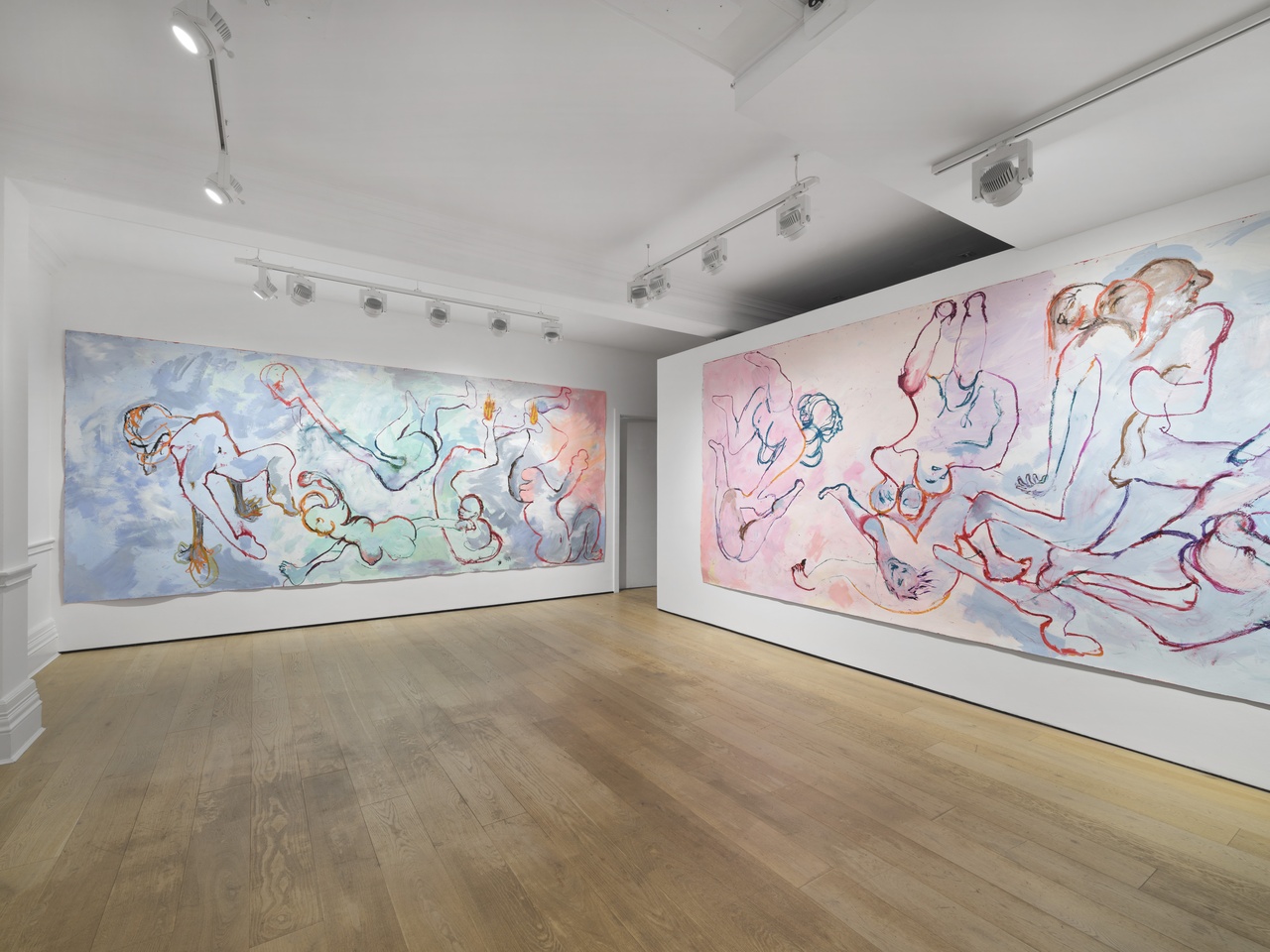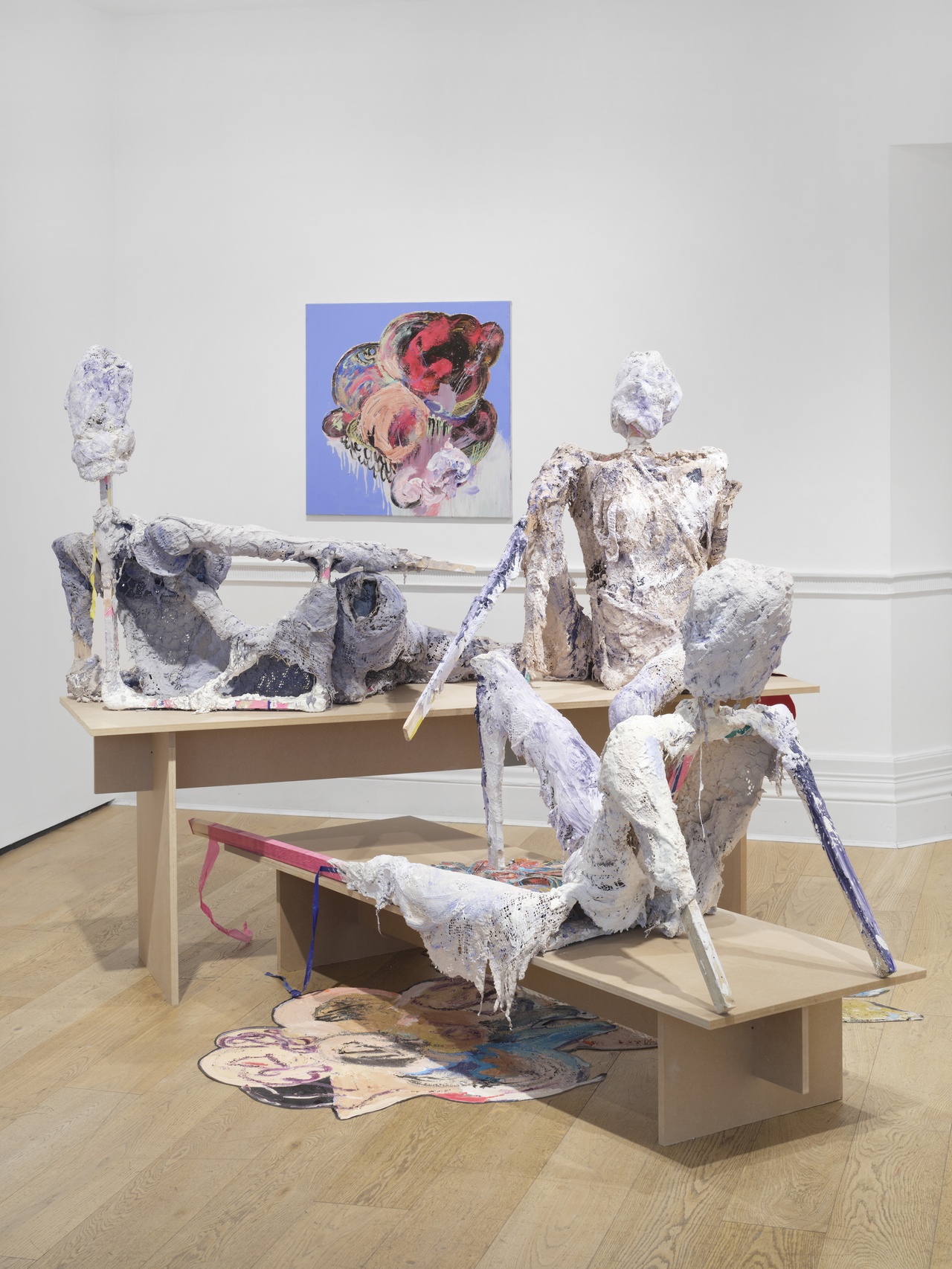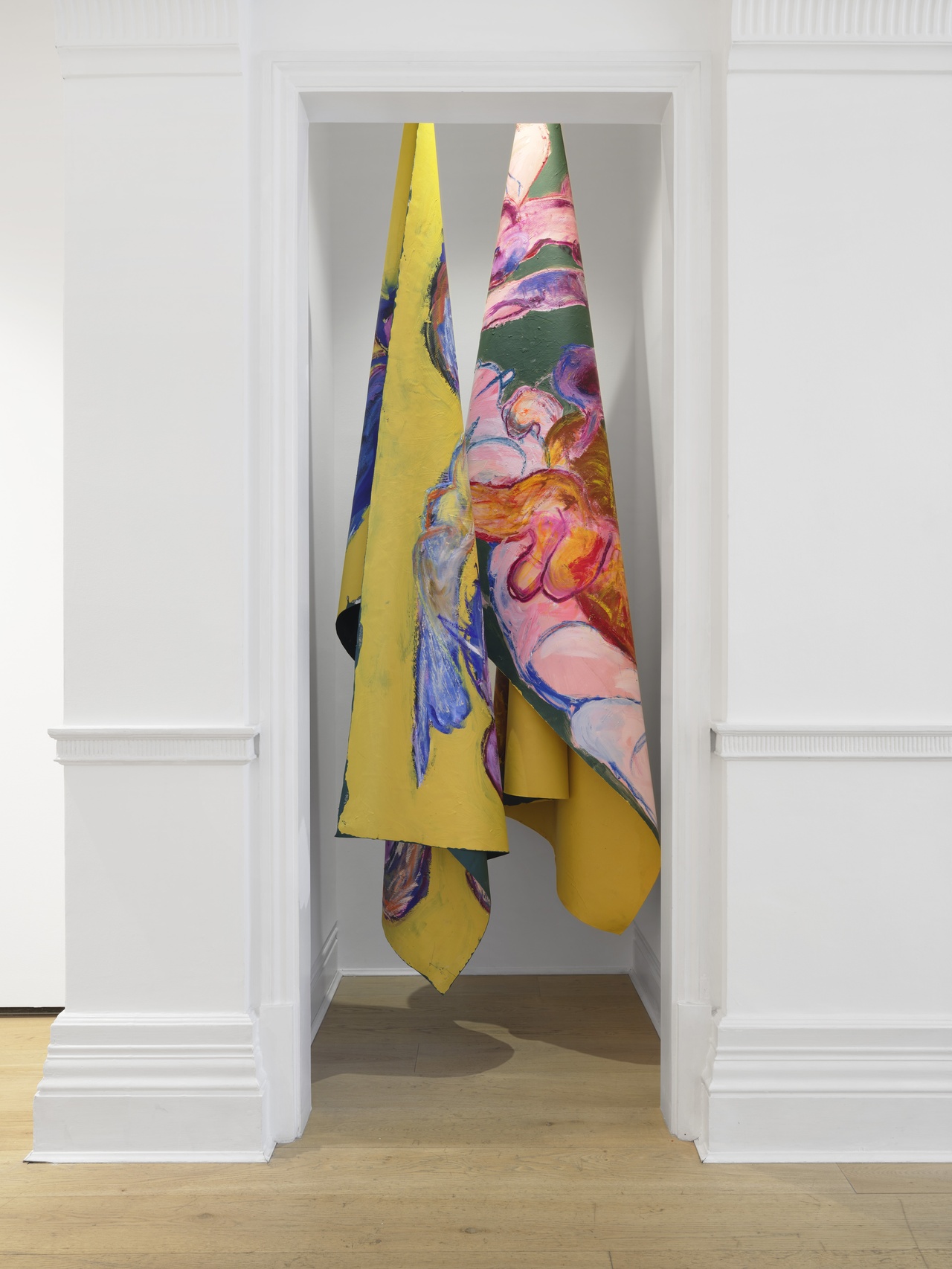SHAPES TRANSFORMED TO BODIES STRANGE Isabelle Bucklow on Florence Peake at Richard Saltoun Gallery, London

“Florence Peake: Enactment,” Richard Saltoun, London, 2023, installation view
In London, at the end of May, Richard Saltoun Gallery presented “Enactment” – a solo exhibition of new installations, sculptures, canvases, and drawings by Florence Peake. A month prior, just across the river, an interdisciplinary installation by Peake opened at Southwark Park Galleries. The shows ran in and out of sync with another. At the time of writing, both London exhibitions have ended, soon to travel on to Towner Eastbourne and Fruitmarket, Edinburgh.
“Factual Actual: Ensemble,” at Southwark Park Galleries, was itself split across two sites. In the Lake Gallery, a 50-meter-long canvas frieze ribboned along the walls, its frenetic ground of mark-making created from a two-day community dance workshop for over 55s. The canvas was then brought back to Peake’s studio and refined. Over six weeks – and six meters at a time – Peake shaped those gestural marks (that, as she later shared in conversation, were somewhat derivative of a particular strain of 1970s feminist performance) into a continuous narrative of cartoon-like figures gesticulating and interpenetrating. The strange bodies – conjoined by limb, mouth, and anus – tumble as if propelled by some invisible current. Caught in metamorphic flux, they form tangled impasto Möbius loops, confusing boundaries between interior and exterior.
In the Dilston Gallery, the bodies reappeared on seven unstretched canvases – rigged up to the rafters of the high-vaulted early-Italian-style church architecture – over a slick white vinyl dance floor. In a near perpetual state of waiting, three performances saw the canvases lowered and hoisted back up by dancers manipulating a pulley system. Eased down with evident control, a slight loosening of grip then rushed the canvas to the floor, the rigid fabric forming sharp folds as it slumped into its newly floor-bound state. Now on a shared plane with performers and audience, the canvas participated in a continuum of ontological shifts: it was unfurled, scrunched, wrapped, painted, compacted, flipped, dragged across the dance floor, then swept up and over a select few of us in the audience. Whilst we sat in darkness beneath the raw uncoated calico, others saw the performance continue. We only heard feet padding, skidding, squeaking. Knowing only the sensation of being inside, I imagined the scene from the outside, figuring it something like Mike Kelley’s Lumpenprole (1991), where uncanny bulges – caused by hidden toys – swell beneath a large blanket laid across the floor. How easily I assumed the role of an object.

Florence Peake, “Factual Actual I” and “Factual Actual II,” 2020
Working within the frame and conventions of the commercial Richard Saltoun Gallery, “Enactment” accommodated no live choreographic performance. Its press release positioned the exhibition as “complementary” to the “major solo show” on the other side of town. Whilst sharing formally similar – albeit more modest – works, “Enactment” was at a spatial and temporal remove from “Factual Actual: Ensemble.” Tempting, then, to read the works in “Enactment” within the frame of afterness, as epiphenomena, and as recalcitrant props attributable to an earlier performance. Yet such a reading – and these there have been – exposes a nagging commitment to the teleological narrative of linear time and a causal desire to cast the live performance as the progenitive moment, the canvases and sculptures as mere byproducts. Peake’s work instead calls for an expanded understanding of live(li)ness that troubles any attempts to enforce hierarchical order or anthropocentric bias. Both “Enactment” and “Factual Actual: Ensemble” staged a recursive return to, and ongoing reckoning with, the simultaneous and intra-acting relations between painting, sculpture, and performance.
In relational psychoanalysis, the term enactment describes the non-verbal reexperiencing of an unconsciously assumed role. In the consulting room, the process involves a dyadic interaction between therapist and patient. I arranged a call to speak with Peake about “Enactment.” Having known that she worked for some decades teaching dance in psychiatric units, I asked if she was aware of the therapeutic context of the term. She was not, however, though she did recall that she used to see an analyst who was a follower of Donald Winnicott, best known for his work in the field of object relations theory. Peake’s sessions would begin by a sandpit, surrounded by a vast collection of toys. She would be asked to select toys and move them into the sandpit, constructing scenes (perhaps a blanket was laid over them?) that would then be deconstructed and analyzed throughout the session.
“Enactment” at Richard Saltoun played out a number of mise-en-scènes, primarily interrogating the relationship between painting and sculpture. Twelve paintings, two draped canvases, and three sculpted figures populated the space. Whilst the paintings shared coagulated intestinal textures and a polychromatic erotic fecundity, the greyed and gutted sculpted figures feebly propped themselves up on brittle wooden limbs. “Sculpture is something you bump into when you back up to look at a painting” said Ad Reinhardt, and, in this Mayfair townhouse, the centrally located sculptures blocked the prime sightlines for three paintings. [1] Reinhardt’s statement suggests a ranking of superiority that revisits the Renaissance paragone debate, which sought to determine the relative status of painting and sculpture (he was clearly on the side of painting). Physically placing her paintings and sculptures opposite one another in space was not an attempt to resuscitate a centuries-old competition, this was not a face-off; rather, Peake was facilitating an interaction. This positioning acknowledged a potent relation between the two, constructing a scenario for sculpture and painting to play out their roles: sculpture is something that looks at painting (and painting looks back). As an additional viewer of the paintings, you either chose to participate in an intersubjective viewership with the sculpture, or obstinately get in its way.

“Florence Peake: Enactment,” Richard Saltoun, London, 2023, installation view
Just like the arrangement of things in space, the placement of words in a clause establishes, as the scholar Mel Y. Chen (whose work traverses queer theory, critical race theory, and animal studies) notes in their book Animacies, “a conceptual order of things, an animate hierarchy of possible acts” and agential roles. [2] What is said, named, and produced through the speech act (as Judith Butler has shown) has performative consequences in determining what is considered real, as well as what is animate/inanimate. Physicist and queer theorist Karen Barad acknowledges how Butler’s concept of performativity challenged a “belief in the power of words to represent pre-existing things,” exposing the artifice of a convention that separates the world into the ontologically disjointed domains of words and things. [3] In Animacies Chen too studies how through linguistic usage hierarchical orders of matter can be deployed. They can also be reworked. [4] Peake reworks Reinhardt’s statement: sculpture is something that looks at painting. In her set-up, the sculpture exerts a dispossessive force, destabilizing the primacy of the human viewer. That sculpture looks at painting establishes matter, to quote Barad, as “not a thing, but a doing, a congealing of agency. Matter is a stabilizing and destabilizing process of iterative intra-activity.” [5]
Back in Richard Saltoun, inhabiting an architectural niche, two canvases – like those rigged to the ceiling of Dilston Gallery, only smaller – were hung at viewing height, directly facing, rather than looming high above or resting directly on top of, the gallery visitor. The draped folds, exposing both painted front and raw back, had something of Jean Siméon Chardin’s La Raie (1728): that oh-so-devastating oil painting of a trapezoidal fish hooked up against a cold wall, caught somewhere between life and death, its innards oozing from a cut in its leathery underbelly. The author Marcel Proust observed of Chardin’s flayed fish “you can admire the beauty of its vast and delicate architecture, tinted with red blood, blue nerves and white muscles, like the nave of a cathedral in polychrome.” [6] La Raie is a fish, it is a cathedral, and it is paint. Peake’s canvases images, objects, agents.

Florence Peake, “Drape 1,” 2022, and “Drape 2,” 2023
I’m finding in Chardin’s fish infinite ways to think with Peake’s work. And like Chardin’s ray-fish caught between life and death, the hanging canvas is poised between painting and sculpture. I’ll allow myself but one more: that cut down the belly of the fish – whilst René Descartes’s cogito made a definitive cut between subject/object and mind/body, Karen Barad’s notion of agential cuts is not “some absolute separation but a cutting together/apart.” [7] Agential cuts are contingent stabilizations that produce the very boundaries through which we might perceive the inside and outside of discrete things. This, I think, helps, nuance Peake’s reckoning between sculpture and painting as not an essentialist stand-off between fixed properties/capacities but an enactment of doings that offer a momentary glimpse into the mutually constituting intra-actions of phenomena.
The anthropocentric desire to read Peake’s performance work as creative of, or bestowing a liveness to, painting and sculpture is to deny their own ongoing animacy. In our conversation, Peake shared that the last exchange she had with her mother, the artist Phyllida Barlow, was about the relationship between painting and sculpture, a relation Peake says remains unresolved. And so it will be: a relation never to be wholly grasped, only enacted.
“Florence Peake: Enactment,” Richard Saltoun Gallery, London, May 30–July 8, 2023.
Isabelle Bucklow is a London-based writer, researcher, and editor. She is the cofounding editor of motor dance journal.
Image credit: Courtesy Richard Saltoun Gallery, London and Rome, © the artist, photos Ben Westoby
Notes
| [1] | A much-cited but unsourced quote attributed, apocryphally, to Ad Reinhardt, dated some time in the 1950s. |
| [2] | Mel Y. Chen, Animacies: Biopolitics, Racial Mattering, and Queer Affect (Durham, NC: Duke University Press, 2012) 3. |
| [3] | Karen Barad, “Posthumanist Performativity: Toward an Understanding of How Matter Comes to Matter,” Signs 28, no. 3 (Spring 2003): 801–31, at 802. |
| [4] | Chen, Animacies, 13. |
| [5] | Barad, “Posthumanist Performativity,” 822. |
| [6] | Marcel Proust, “Chardin: The Essence of Things,” trans. Mina Curtiss, in Against Sainte-Beuve and Other Essays (London: Penguin, 1988), 104. |
| [7] | Karen Barad, “Nature’s Queer Performativity,” Kvinder, Køn og Forskning 1–2 (2012): 25–54, at 46. |
